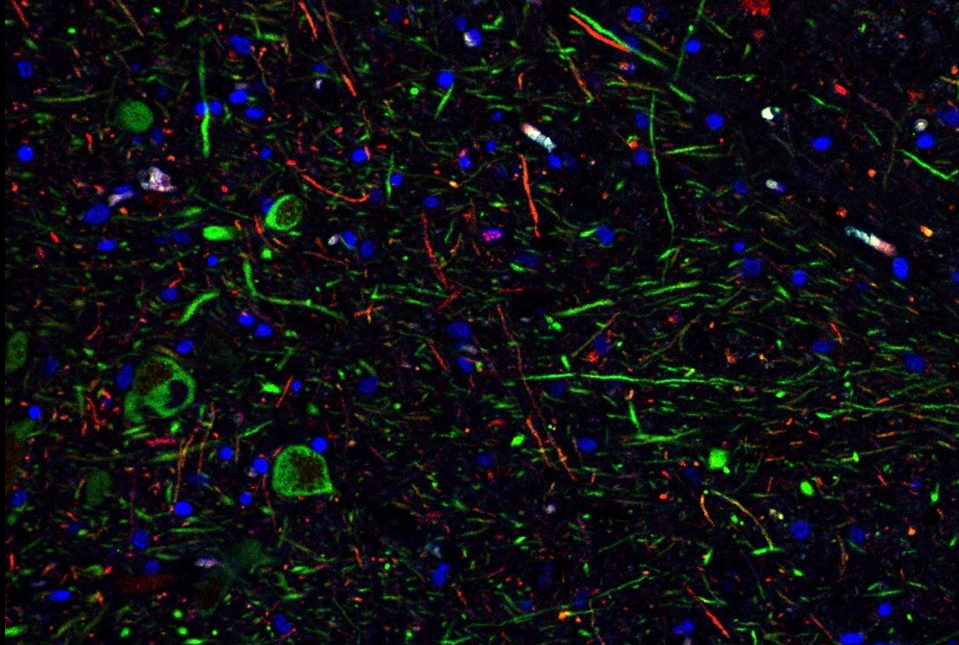SARS-CoV-2可感染多巴胺神经元导致衰老
概要
一项新研究发现,SARS-CoV-2病毒能感染大脑中的多巴胺神经元并引发其衰老,导致细胞失去生长和分裂能力。这一发现可能揭示了长新冠相关的神经症状,如脑雾、嗜睡和抑郁的潜在机制。研究人员发现,感染了SARS-CoV-2的多巴胺神经元会停止工作,并发出导致炎症的化学信号。多巴胺神经元在愉悦感、动机、记忆、睡眠和运动中发挥重要作用,其受损也与帕金森病有关。
研究人员表示,这是一个完全出乎意料的结果。他们最初的研究目的是了解SARS-CoV-2如何影响不同细胞,但在测试肺细胞、心脏细胞、胰腺β细胞后,发现只有多巴胺神经元中的衰老途径被激活。他们发现,受感染的多巴胺神经元约占5%,虽然感染率较低,但即使是小部分受感染的细胞也可能造成严重影响。此外,并非所有类型的神经元细胞都容易受到病毒感染,研究人员观察到,在相同的实验条件下,皮质神经元不会受到SARS-CoV-2感染。
由于多巴胺神经元衰老是帕金森病的标志,研究人员建议对长新冠患者进行监测,以防出现帕金森病相关症状的风险增加。
SARS-CoV-2 Can Infect Dopamine Neurons Causing Senescence

Stained tissue from the midbrain of a COVID-19 patient shows DNA in the cells' nuceli (blue), dopamine neurons (green) and phosphor-alpha-synuclein (red). Credit: Liuliu Yang.
A new study reported that SARS-CoV-2, the virus that causes COVID, can infect dopamine neurons in the brain and trigger senescence—when a cell loses the ability to grow and divide. The researchers from Weill Cornell Medicine, Memorial Sloan Kettering Cancer Center and Columbia University Vagelos College of Physicians and Surgeons suggest that further research on this finding may shed light on the neurological symptoms associated with long COVID such as brain fog, lethargy and depression.
The findings, published in Cell Stem Cell on Jan. 17, show that dopamine neurons infected with SARS-CoV-2 stop working and send out chemical signals that cause inflammation. Normally, these neurons produce dopamine, a neurotransmitter that plays a role in feelings of pleasure, motivation, memory, sleep and movement. Damage to these neurons is also connected to Parkinson’s disease.
“This project started out to investigate how various types of cells in different organs respond to SARS-CoV-2 infection. We tested lung cells, heart cells, pancreatic beta cells, but the senescence pathway is only activated in dopamine neurons,” said senior author Dr. Shuibing Chen, director of the Center for Genomic Health, the Kilts Family Professor Surgery and a member of the Hartman Institute for Therapeutic Organ Regeneration at Weill Cornell Medicine. "This was a completely unexpected result.”
Determining How SARS-CoV-2 Impacts Different Cells
Previously, Dr. Chen led the effort to generate multiple cell types from human stem cells and tested them to see which ones SARS-CoV-2 could infect. This allowed the researchers to survey the spectrum of tissues that might be infected during COVID, which has a diverse array of symptoms in different patients. They also studied autopsy samples from patients infected with the virus to confirm their observations from the lab grown cells.
Surprisingly, they found that a small percentage of dopamine neurons exposed to SARS-CoV-2 were infected, approximately five percent. “The infection rate of dopamine neurons isn’t as high as lung cells, the virus’s main target, but even a small population of infected cells can potentially have a severe effect,” said Dr. Chen.
Interestingly, not all neuronal cell types were vulnerable to viral infection. The researchers observed that cortical neurons were not permissive to SARS-CoV-2 infection under identical experimental conditions.
Protecting Dopamine Neurons
In this paper, the researchers used transcriptional profiling to identify how SARS-CoV-2 infection modified gene activity and the resulting changes in the way cells behaved. “We discovered that only dopamine cells had the senescence pathway activated,” said Dr. Chen. In stark contrast, the genes in the senescence pathway were not significantly turned on with SARS-CoV-2 infected lung organoids, pancreatic cells, liver organoids or heart cells.
The researchers found that the gene signatures—the unique pattern of gene activity—from the infected lab-grown dopamine neurons and the dopamine neurons from COVID autopsy samples were the same. This included genes that triggered chemical signals for inflammation.
Next, they looked for ways to protect the neurons to reduce the risk of neurological defects when a patient is infected by the virus.
The researchers tested drugs already marketed for various conditions to find one that either prevented SARS-CoV-2 infection or rescued infected dopamine neurons from senescence. The screen identified three drugs that blocked SARS-CoV-2 infection thereby preventing the dopamine cells from senescence: riluzole (treats ALS or Lou Gehrig’s disease), metformin (treats diabetes) and imatinib (treats cancer). Further study on these drugs may lead to a way to prevent the virus’s attack on the brain.
Though most people are exposed to COVID, only certain individuals will be impacted since many factors are involved in the risk for neurological symptoms including severity of the disease and genetics. Human population studies are exploring this aspect further.
While the clinical relevance of these findings is still unclear, since dopamine neuron senescence is a hallmark of Parkinson’s disease the researchers suggest that long COVID patients should be monitored for an increased risk of developing Parkinson’s-related symptoms. To date Parkinson’s symptoms have not been overly reported in population studies.
Source:
Weill Cornell Medicine
Published on 17 January, 2024
声明:本站文章版权归原作者及原出处所有。本文章系本站编辑转载,文章内容为原作者个人观点,登载该文章的目的是为了学习交流和研究,并不代表本站赞同其观点和对其真实性负责,本站只提供参考并不构成任何投资及应用建议。
本站是一个学习交流和研究的平台,网站上部分文章为引用或转载,并不用于任何商业目的。我们已经尽可能的对作者和来源进行了告知,但是能力有限或疏忽,造成漏登或其他问题,请及时联系我们,我们将根据著作权人的要求,立即更正或删除有关内容。本站拥有对本声明的最终解释权。








